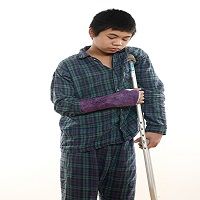Article
New Virus? Unexplained Pediatric Paralysis in Denver, Syracuse
Author(s):
Concerned about a mysterious outbreak of pediatric paralysis, the US Centers for Disease Control and Prevention (CDC) has asked physicians to report any similar cases. In Denver, CO, 10 children have been admitted to Children's Hospital Colorado with limb weakness and paralysis since Aug. 1, according to the hospital.

Doctors at the US Centers for Disease Control and Prevention are investigating a mysterious outbreak of pediatric paralysis in Denver, CO. Some--but not all--of those cases involve children who tested positive for Enterovirus-D68.
Ten children have been admitted to Children’s Hospital Colorado in Denver, CO, since Aug.1 with limb weakness and paralysis, according to the hospital.
Meanwhile, at Upstate Golisano Children’s Hospital in Syracuse, NY, pediatrician Jana Shaw, MD, MPH, said she treated two children with unexplained limb weakness with onset after they had upper respiratory infection symptoms. Those were later confirmed to be due to EV-D68. But that does not explain the paralysis, Shaw said.
Similar cases have been described in Ann Arbor, MI, and Kansas City, MO. But so far, doctors are baffled.
"It could be a new virus for which we don't have diagnostics," Shaw said in an interview, or EV-D68 could be playing a role. Both of her patients, one of whom has been hospitalized for 17 days, were brought in because of the limb weakness, not the respiratory symptoms. "It's a very uncommon problem," Shaw said. "We are not used to seeing this." Polio virus was suspected, but the children had both been vaccinated, she said.
Both patients got MRI scans, but neither showed spinal cord lesions, so the cases did not meet the CDC's threshold for cases that should be reported.
On Sept. 26, the CDC described the Denver cases as “acute neurologic illness of undetermined etiology” and issued an official advisory though its Health Alert Network asking physicians and others to report any such cases to state and local authorities, or to the CDC. Nine children’s cases were cited in the advisory, but another case was later confirmed by the hospital.
In Denver news accounts, doctors said it was too soon to know if the children's paralysis and weakness would be permanent or long-lasting. They also expressed concern that more cases would emerge.
All the Denver patients had lesions on the gray matter of their spinal cords that showed up on MRI scans. But none had cortical, subcortical, basal ganglia, or thalamic lesions, the CDC said. Testing has resulted in inconclusive results. Most of the children had a febrile illness before showing the neurological symptoms. When nasopharyngeal specimens were tested for various pathogens, 6 of 8 tested for enterovirus/rhinovirus were positive for enterovirus, and so far 4 of those turned out to be cases of Enterovirus-D68 (EV-D68). Testing on the remaining 2 positive specimens is still in process.
When cerebrospinal fluid was tested it was negative for enterovirus, including poliovirus, and negative for West Nile virus.
The CDC said it has not ruled out a link between EV-D68 and the paralysis cases. The EV-D68 virus has now been confirmed in 40 states, and the CDC's laboratory has been overwhelmed with specimens for testing.
At the New York State Department of Health a spokesman said the department was cooperating with the CDC’s investigation, but had not receive any reports of children with acute focal limb weakness or paralysis.
The CDC advisory asked health departments needing laboratory of epidemiologic support to call the CDC’s emergency operations center at (770) 488-7100 or by e-mailing limbweakness@cdc.gov.
Shaw’s account of the hospital’s response to EV-D68 was reported in Jama Pediatrics





